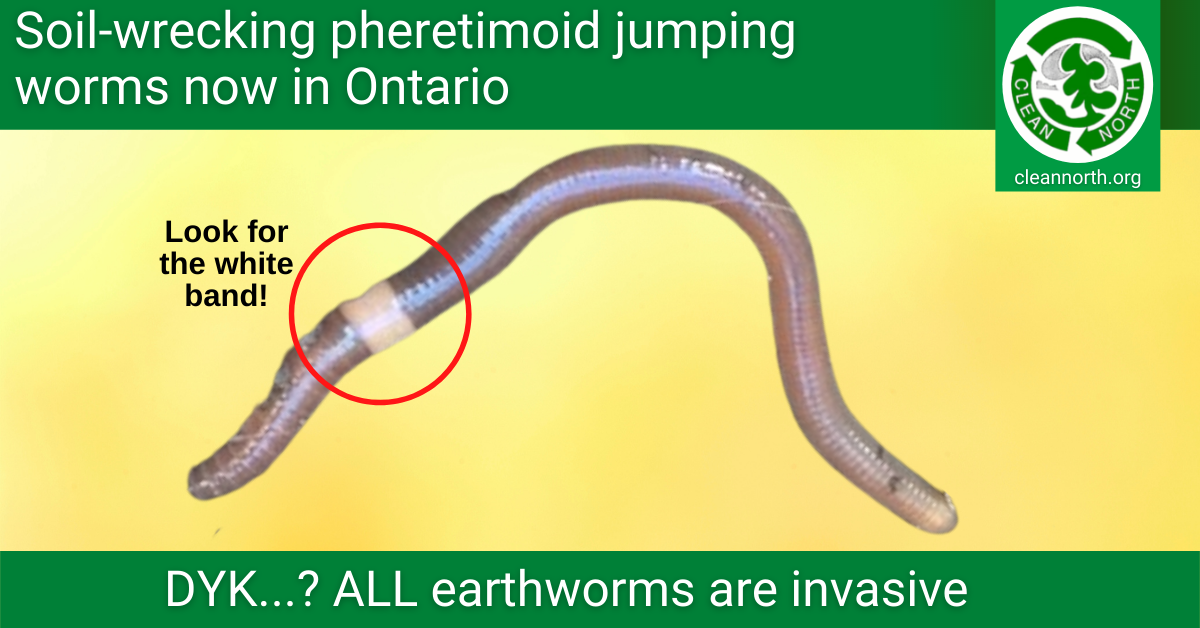By Cathy Kavassalis, master gardener and administrator, Master Gardeners of Ontario Facebook group

Pheretimoid jumping worms have now been confirmed in Ontario. These worms have been identified thanks to the observation and reports of citizen scientists in the Master Gardeners of Ontario Facebook group.
Dr. Michael McTavish (S.M. Smith Forest Health Lab) collected samples from members and confirmed their identity with the expertise of Dr. John W. Reynolds (Oligochaetology Laboratory).
Dr. McTavish writes: “Altogether, the five collections captured four species of pheretimoid jumping worm, including two that were found in that initial 2014 Essex County collection (Amynthas agrestis, Amynthas hilgendorfi syn. Metaphire hilgendorfi) and two new species that have not yet been recorded in Canada (Amynthas minimus, Pithemere bicincta). The distribution is as follows:
- Wheatley: A. hilgendorfi, A. minimus
- Dundas: A. agrestis, A. minimusEast
- York: A. hilgendorfi, Pithmere bicincta
- Toronto: A. agrestis
- Blythwood Ravine: A. hilgendorfi
“We are currently putting together a short paper on these observations (Reynolds and McTavish, in prep.).”
What does this mean? While all earthworms are invasive in Ontario, jumping worms pose a great risk to our gardens and particularly to northern forests. At least two of the species identified, Metaphire hilgendorfi and Amynthas agrestis, are known to be serious trouble.
At this time, do not move plants with soil to new locations without thoroughly inspecting for worms and or eggs. Root washing is recommended before moving plants. Click to this Wisconsin DNR page for a comparision of jumping worms vs. European nightcrawler.
Earthworms, such as red wigglers (Eisenis fetida) purchased for composting may be contaminated with jumping worms.
Earthworms purchased for fishing bait, such as European nightcrawlers (Lumbricus terrestris) may also be contaminated.
A jumping worm is like a nightcrawler on steroids, “instead of inching along like garden worms, they snap their bodies like angry rattlesnakes.” Unlike other earthworms, pheretimoid jumping worms live in the topmost layer of soils consuming all fallen organic matter, including seeds, turning leaves into a material that resembles coffee grounds. In the absence of worms, a healthy forest develops a thick blanket of duff (leaf litter) that slowly decomposes over time.
“That layer creates a home for insects, amphibians, birds, and native flowers. But when worms show up, they devour the litter within the space of a few years. All the nutrients that have been stored up over time are released in one giant burst, too quickly for most plants to capture. And without cover, the invertebrate population in the soil collapses” (The Atlantic).
Pheretimoids have become a leading ecological concern in hardwood forests. They also present threats to agriculture, nursery production and home gardeners.
These worms have an annual life cycle. They die in the fall but leave tiny cocoons that spend the winter in the soil. They are parthenogenic, which means they can reproduce without fertilization. One worm is enough to launch an invasion.
They are difficult to stop … so it is up to us to slow their spread!
There is hope:
- Some fungi kill them. (Entomopathogenic fungus Beauveria bassiana shows some promise).
- Some saponins kill them (soaps).
- Solarization of compost and mulch may help, but you have to get it hot enough.
- Sharp angular particles like biochar, sand and diatomaceous earth seem to deter them and may kill worms when ingested.
Please be on the look out for jumping worms:
- Inspect all plants and soil for earthworms, eggs or cocoons.
- Remove any you find.
- Do not move plant material to cottages or other properties that contain any worms.
If you find jumping worms, contact your local Canadian Food Inspection Agency office (CFIA).
Learn more:
- Jumping Worms: The Upcoming Environmental Disaster
- Jumping Worms: The Creepy, Damaging Invasive You Don’t Know
- Jumping worm (Amynthas species)
- 211-Invasive Asian Jumping Worms: What Gardeners Need to Know
- GOT WORMS? Introduction to Invasive Asian Earthworms
- Invasive in the Spotlight: Jumping Worms
- Reynolds, J.W. 1977. The earthworms (Lumbricidae and Sparganophilidae) of Ontario. Life Sci. Misc. Publ., Roy. Ont. Mus. xi + 141 pp. [English; abstr. English].
- Nouri Aiin, Maryam & Gorres, Josef. (2021). Biocontrol of invasive pheretimoid earthworms using Beauveria bassiana. PeerJ. 9. e11101. 10.7717/peerj.11101.




